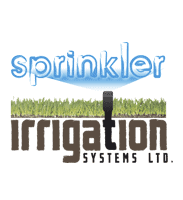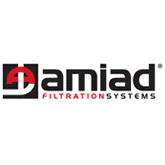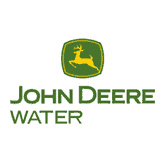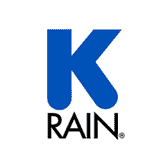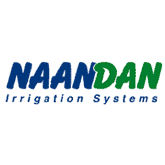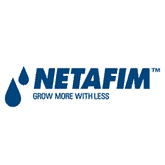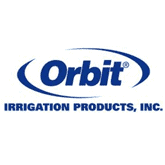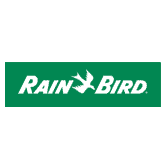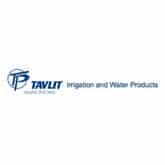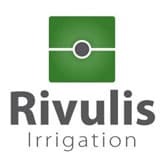Irrigation Water Tanks & Water Pumps
Types of Water Pumps
Pumps commonly used for irrigation fall into the following categories based on the design of the pump. This tutorial addresses electric powered pumps only. While most of the information here also applies to fuel powered pumps the formulas don’t! You must use different formulas for calculating the size and flow information for fuel powered pumps. If you have an engine powered pump (gas, diesel, propane, corn liquor, etc.) you should contact the pump manufacturer and request a copy of the pump performance curve. As a general rule, fuel powered pumps require more horsepower than electric pumps.
Displacement Water Pumps
Displacement pumps force the water to move by displacement (bet you couldn’t have guessed!) This means pumps such as piston pumps, diaphragm pumps, roller-tubes, and rotary pumps. The old fashioned hand-pumps, the ones you operate by moving a long lever handle up and down, are piston displacement pumps. So are those grasshopper-like oil well pumps. Displacement pumps are used for moving very thick liquids, creating very precise flow volumes, or creating very high pressures. In addition to oil wells they are also used for fertilizer injectors, spray pumps, air compressors, and hydraulic systems for machinery. With the exception of fertilizer injectors (used for mixing fertilizer into irrigation water) you will not see them typically used for irrigation systems, so that is all I’m going to say about them.
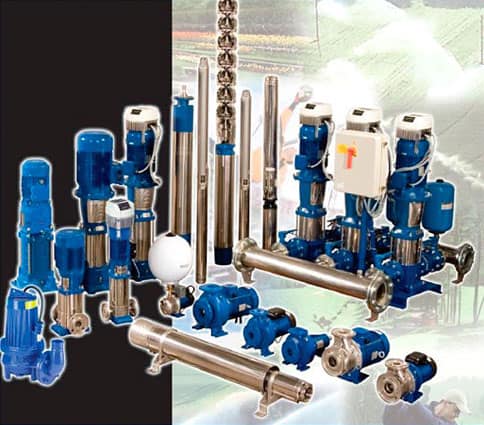
Centrifugal Water Pumps
Almost all irrigation pumps fall into this category. A centrifugal pump uses an “impeller” (sort of like a propeller, but a little different) to spin the water rapidly in a “casing”, “chamber”, or “housing” (any of those terms may be used). This spinning action moves the water through the pump by means of centrifugal force. Centrifugal pumps may be “multi-stage”, which means they have more than one impeller and casing, and the water is passed from one impeller to another with an increase in pressure occurring each time.
Each impeller/casing combination is referred to as a “stage”. All centrifugal pumps must have a “wet inlet”, that is, there must be water in both the intake (inlet) pipe and the casing when the pump is started.
They can’t suck water up into the intake pipe. They must be “primed” by adding water to the intake pipe and case before the first use. To prime them you simply fill the intake pipe with water and then quickly turn on the pump. To put it simply, this type of pump can’t suck air, only water, so if there is no water already in the pump it won’t pull any water up into it.
Once it gets water in it the first time, most centrifugal pumps are designed to hold the water with a small valve so the pump doesn’t need to be primed again every time you turn it on.
End-Suction Centrifugal Water Pumps
The most common type of pump. Typically the pump is “close-coupled “to an electric motor, that is, the pump is mounted right on the end of the motor’s drive shaft and the pump case is bolted straight into the motor so that it looks like a single unit.
The water typically enters the pump through a “suction inlet “centred on one side of the pump, and exits at the top. Almost all portable pumps are end-suction centrifugal type pumps.
If the pump isn’t one of the next two types, then chances are it is an end-suction centrifugal. End-suction centrifugal pumps generally need to be primed the first time they are used (including many so-called self-priming models,) after that most will not require priming unless a leak develops in the intake pipe. If the pump needs to be primed each time it is turned on this almost always means there is a tiny leak in the intake pipe.
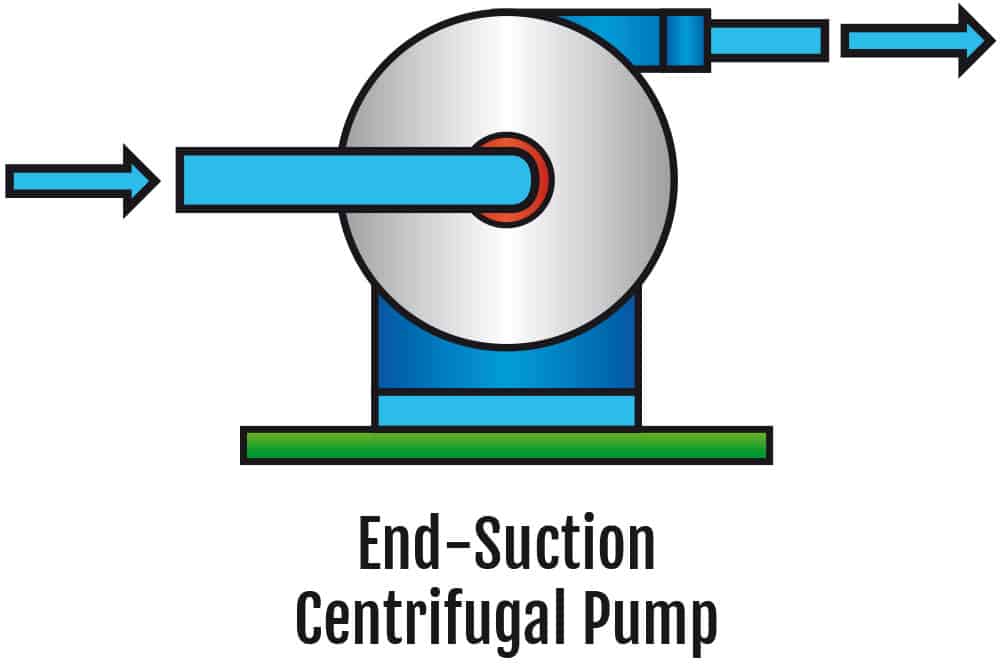
End-Suction Centrifugal are designed to push water, not pull it. They are great for use as irrigation booster pumps. They are also very good for pumping water from any source where the water level is higher than the pump, where the water can flow down an intake pipe to the pump using gravity.
But any time they need to actually suck the water up into the pump they perform much less efficiently. Therefore end-suction centrifugal pumps are not the best choice for drawing water from a water source that is lower than the pump, ie; they are not good when mounted on the bank of a pond, stream, river, etc.
When sucking water up into the pump they must be installed as close to the water surface level as possible, which is often inconvenient. Each pump is different, so check with the manufacturer to determine the maximum height the pump can be above the water surface.
As a general rule they perform very poorly if they are more than 5 feet above the water surface. Just remember, end-suction centrifugal pumps are great at pushing water, but they suck at sucking it!
Submersible Water Pumps
Submersible pumps are installed completely underwater, including the motor. The pump consists of an electric motor and pump combined in a single unit.
Typically the pump will be shaped like a long cylinder so that it can fit down inside of a well casing. Although most submersible pumps are designed to be installed in a well, many can also be laid on their side on the bottom of a lake or stream.
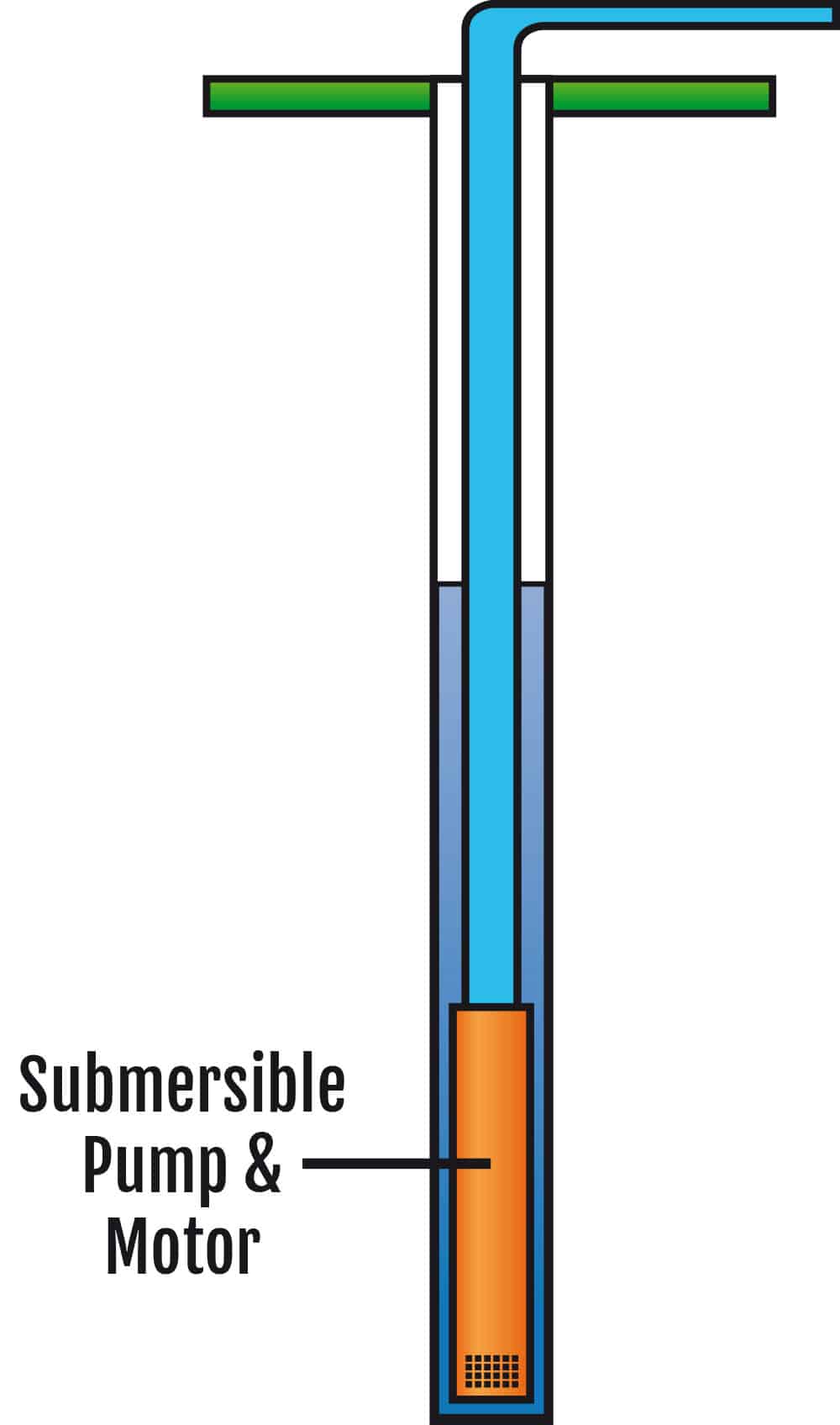
Another common installation method for lakes and rivers is to mount the submersible pump underwater to the side of a pier pile (post). Submersible pumps don’t need to be primed since they are already under water. They also tend to be more efficient because they only push the water, they don’t need to suck water into them. Most submersible pumps must be installed in a special sleeve if they are not installed in a well, and sometimes they need a sleeve even when installed in a well.
The sleeve forces water coming into the pump to flow over the surface of the pump motor to keep the motor cool. Without the sleeve the pump will burn up. Because the power cord runs down to the pump through the water it is very important that it be protected from accidental damage. You wouldn’t want a boat tangled up in the cord or a snapping turtle or alligator to bite through it!
Turbines and Jet Water Pumps
A turbine pump is basically a centrifugal pump mounted underwater and attached by a shaft to a motor mounted above the water. The shaft usually extends down the centre of a large pipe. The water is pumped up this pipe and exits directly under the motor.
Turbine pumps are very efficient and are used primarily for larger pump applications. Often they consist of multiple stages, each stage is essentially another pump stacked on top of the one below.
It works like a train with multiple engines hitched together pulling it, each stage would be a engine. Turbine pumps are typically the type of pumps you see on farms. When you see a huge motor mounted on its end and a pipe coming out sideways below the motor, that is most likely the motor for a turbine pump down inside the well.
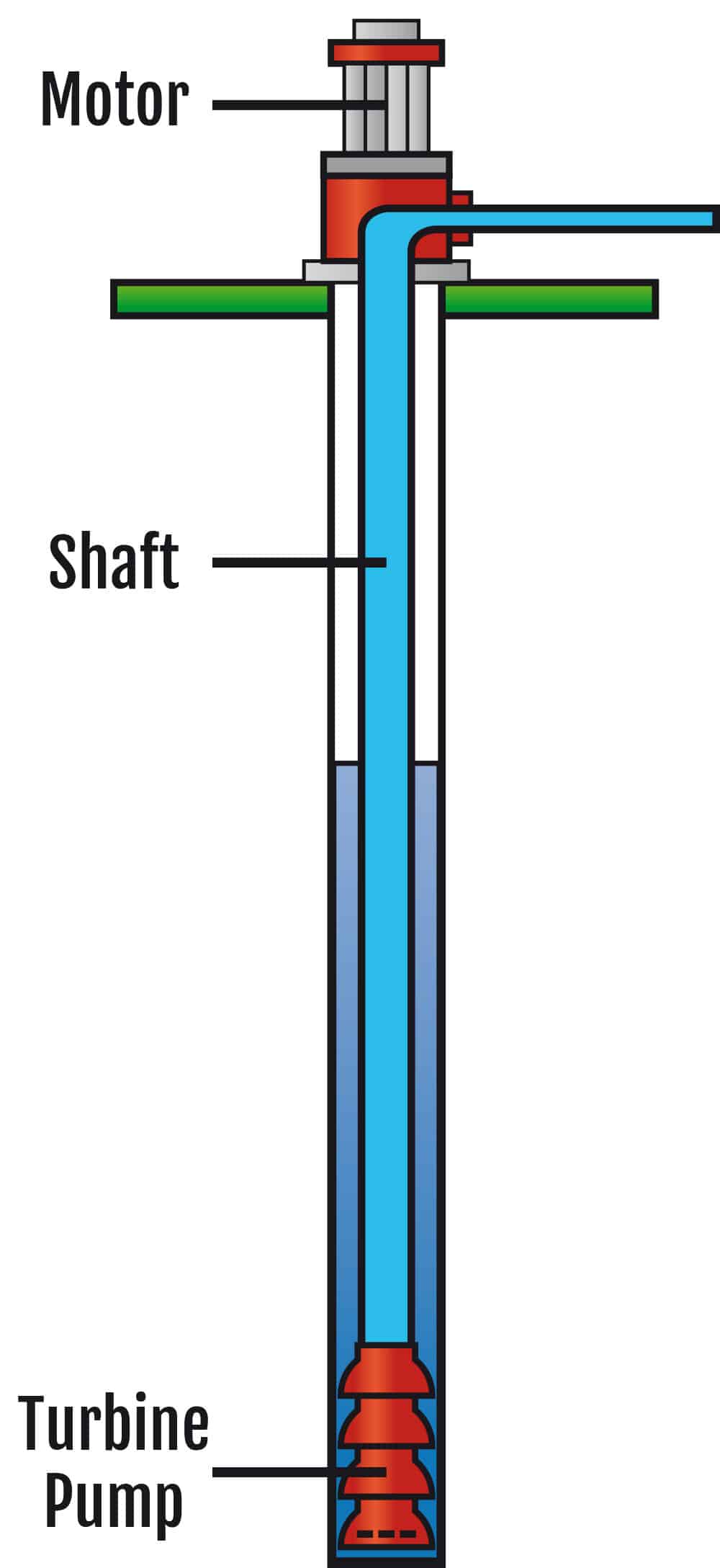
I use turbine pumps for large parks and golf courses where we are pumping from lakes. The turbine pump is mounted in a large concrete vault with a pipe connecting it to the lake. The water flows by gravity into the vault where it enters the pump.
The pump motors are suspended over the vault on a frame. I usually use two or three different sized pumps side-by-side to handle different flow combinations. A jet pump is similar to a turbine pump but it works by redirecting water back down to the intake to help lift the water.
Booster Water Pumps
You’re going to run into the term booster pump now and then as they are common in irrigation, so let’s start by defining it. Most pumps are used to take water from a standing (or non-pressurized) source and move it to another location. For example, a pump might take water from a lake and move it to a sprinkler system.
A booster pump, on the other hand, is used to increase the water pressure of water that is already on its way somewhere. Example; say you have a sprinkler system that needs 80 PSI of pressure to operate.
But the water line coming onto your property only has 50 PSI of pressure. In this cases you would install a booster pump to raise the pressure from 50 PSI up to 80 PSI for your sprinkler system.
So to put it another way, a booster pump is used to “boost “the water pressure. Any of the types of pumps listed below can be used as a booster pump, but almost all booster pumps are the “end-suction centrifugal” type. More on that later.
What is a Floating Pump?
A floating pump is simply a submersible pump or a turbine pump that is attached to the bottom of a float. The pump hangs below the float, and the float is anchored in a lake, pond, or river.
A flexible pipe is used to take the water from the pump to the irrigation system. A floating pump is a good option to look into for installing a pump in a pond or lake.
It is often much easier to install than a standard submersible, jet-pump, or turbine and is much more energy efficient than an end-suction centrifugal. Floating fountains and pond aerators are another utilization of floating pump technology.
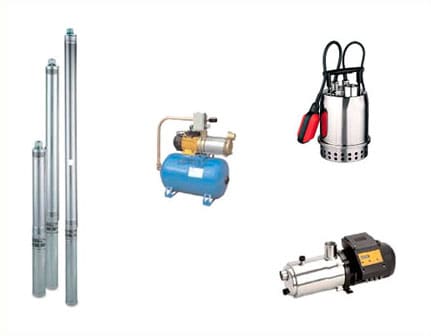
Water Tanks
Water tanks are rotationally moulded in one piece to provide a seamless unit that is environmentally sensitive and cost effective. They are ideally suited as irrigation storage tanks and submersible pumps are easily fitted inside.
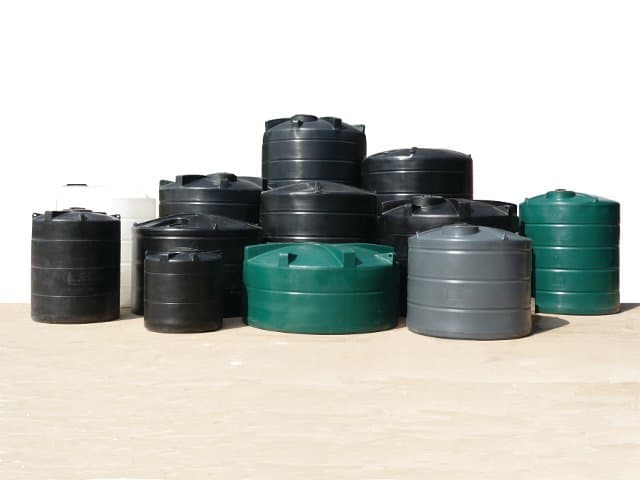
Main Features include: High impact strength at low temps, standard 1″ BSP female connector outlet, 2″ fill point with cap, easily reached filling point, lightweight and easy to handle, BBA approved, ultraviolet stabilised, corrosion resistant, maintenance free, full ventilation.
Bylaw kit, including warning pipe and a breather vent, should be fitted to tanks used for water storage.
Water tanks are ideal for irrigation water storage. A large number of sizes and shapes are available (all in different colours) and come with a conditional guarantee. The tanks require a firm level base. A bylaw kit should be fitted to all tanks that are supplied via a ball valve from mains water.
The most common set up is a submersible pump positioned on the bottom of the tank. It is necessary to drill a hole in the top front section of the tank and a tank connector is used to join the irrigation pipe work to the pump hose inside the tank. A high pressure ball valve can also be fitted alongside for filling the tank. This type of set up is very discreet and no pump house or shelter is required.
Not sure what you need?
Not sure what you need?
We offer free expert advice and a full Irrigation design service is available simply call:
We offer free expert advice and a full Irrigation design service is available simply call:
01384 423150 or 01384 913150
01384 423150 or 01384 913150
